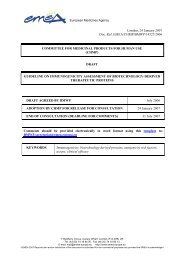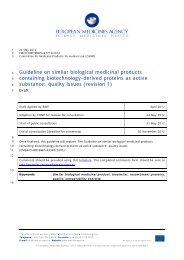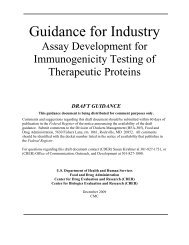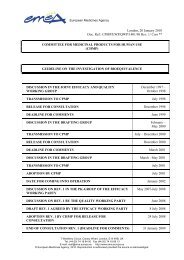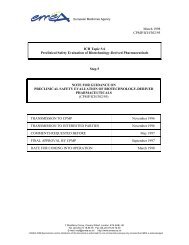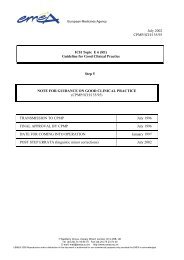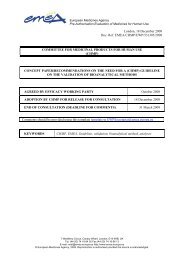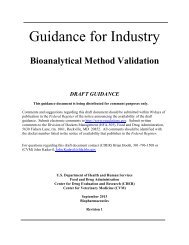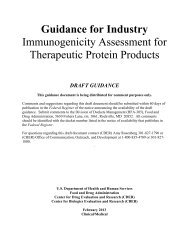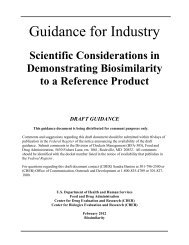EPO Biosimilars EPO Oct. 2005
GUIDANCE ON BIOSIMILAR MEDICINAL PRODUCTS CONTAINING RECOMBINANT ERYTHROPOIETINS http://www.ipm-biotech.de/fileadmin/user_upload/pdf/guidelines/EPO-biosimilars-EPO-Oct2005.pdf
GUIDANCE ON BIOSIMILAR MEDICINAL PRODUCTS
CONTAINING RECOMBINANT ERYTHROPOIETINS
http://www.ipm-biotech.de/fileadmin/user_upload/pdf/guidelines/EPO-biosimilars-EPO-Oct2005.pdf
Create successful ePaper yourself
Turn your PDF publications into a flip-book with our unique Google optimized e-Paper software.
European Medicines Agency<br />
Evaluation of Medicines for Human Use<br />
London, 16 June <strong>2005</strong><br />
EMEA/CHMP/94526/<strong>2005</strong><br />
COMMITTEE FOR HUMAN MEDICINAL PRODUCTS<br />
(CHMP)<br />
ANNEX GUIDELINE ON SIMILAR BIOLOGICAL MEDICINAL<br />
PRODUCTS CONTAINING BIOTECHNOLOGY-DERIVED PROTEINS AS<br />
ACTIVE SUBSTANCE:<br />
NON-CLINICAL AND CLINICAL ISSUES:<br />
GUIDANCE ON BIOSIMILAR MEDICINAL PRODUCTS<br />
CONTAINING RECOMBINANT ERYTHROPOIETINS<br />
DISCUSSION AT THE BMWP WORKING PARTY<br />
APRIL <strong>2005</strong> to JUNE<br />
<strong>2005</strong><br />
TRANSMISSION TO THE CHMP JUNE <strong>2005</strong><br />
RELEASE FOR CONSULTATION JUNE <strong>2005</strong><br />
DEADLINE FOR COMMENTS OCTOBER <strong>2005</strong><br />
7 Westferry Circus, Canary Wharf, London, E14 4HB, UK<br />
Tel. (44-20) 74 18 84 00 Fax (44-20) 74 18 86 13<br />
E-mail: mail@emea.eu.int http://www.emea.eu.int<br />
©EMEA <strong>2005</strong> Reproduction and/or distribution of this document is authorised for non commercial purposes only provided the EMEA is acknowledged
1. Introduction<br />
The Marketing Authorisation (MA) application dossier of a new recombinant erythropoietins claimed<br />
to be similar to a reference product already authorised shall provide the demonstration of<br />
comparability of the product applied for to a reference product authorised in the EU.<br />
Human erythropoietin is a 165 amino acid glycoprotein produced in the kidneys and is responsible for<br />
the stimulation of red blood cell production. Erythropoietin for clinical use is produced by<br />
recombinant DNA technology (Epoetin) using mammalian cells as expression system.<br />
All epoetins in clinical use have a similar amino acid sequence as endogenous erythropoietin but differ<br />
in the glycosylation pattern. Glycosylation is a membrane-bound post-translational process which<br />
influences pharmacokinetics and may affect efficacy and safety, particularly immunogenicity.<br />
Epoetin-containing medicinal products are currently indicated for several conditions such as anaemia<br />
in patients with chronic renal failure, chemotherapy-induced anaemia in cancer patients, and for<br />
increasing the yield of autologous blood from patients in a pre-donation programme. The mechanism<br />
of action of epoetin is the same in all currently approved indications but the doses required to achieve<br />
the desired response may vary considerably and are highest in the oncology indications. Epoetin can<br />
be administered intravenously and subcutaneously.<br />
Recombinant erythropoietins have a relatively wide therapeutic window and are usually well tolerated<br />
provided that the stimulation of bone marrow is controlled by limiting the amount and rate of<br />
haemoglobin increase. The rate of haemoglobin increase may vary considerably between patients and<br />
is dependent not only on the dose of epoetin but also other factors such as iron stores, baseline<br />
haemoglobin, and the presence of concurrent medical conditions.<br />
Exaggerated pharmacodynamic response may result in hypertension and thrombotic complications.<br />
Moreover, pure red cell aplasia (PRCA), due to neutralising anti-erythropoietin antibodies, has been<br />
observed in renal anaemia patients treated with subcutaneously administered epoetin, Because<br />
antibody-induced PRCA is a very rare event and usually takes months to years of epoetin treatment to<br />
develop, such events are difficult to be picked up in pre-authorisation studies.<br />
2. Scope<br />
The guideline on similar biological medicinal products containing biotechnology-derived proteins as<br />
active substance: non-clinical and clinical issues (EMEA/CPMP/42832/05/draft) lays down the<br />
general requirements for demonstration of similar nature of two biological products in terms of safety<br />
and efficacy.<br />
This product specific guidance as an Annex to the above guideline presents the current view of the<br />
CHMP on the application of the guideline for demonstration of comparability of two recombinant<br />
human erythropoietin medicinal products. The final set of studies necessary to fulfill non-clinical and<br />
clinical requirements for a given medicinal product will be determined by data generated by the<br />
comparability exercise itself.<br />
This Guideline should be read in conjunction with the requirements laid down in the EU<br />
Pharmaceutical legislation and with relevant CHMP guidelines (see section 8).<br />
3. Non-clinical studies<br />
Before going in clinical development, non-clinical studies should be performed. These studies should<br />
be comparative in nature and should be designed to detect differences in response to the similar<br />
biological medicinal product and the reference medicinal product and not just the response per se. The<br />
approach taken will need to be fully justified in the non-clinical overview.<br />
3.1 Pharmacodynamics studies<br />
In vitro studies:<br />
In order to assess any alterations in reactivity between the similar biological medicinal product and the<br />
reference medicinal product, data from a number of comparative bioassays (e.g. receptor-binding<br />
EMEA/CHMP/94526/<strong>2005</strong> Page 2/5<br />
©EMEA <strong>2005</strong>
studies, cell proliferation assays), many of which may already be available from quality-related<br />
bioassays, should be provided.<br />
In vivo studies:<br />
The erythrogenic effects of similar biological medicinal product and the reference medicinal product<br />
should be quantitatively compared in an appropriate animal assay (e.g. the European Pharmacopoeia<br />
polycythaemic and/or normocythaemic mouse assay; data may be already available from qualityrelated<br />
bioassays). Additional information on the erythrogenic activity may be obtained from the<br />
described repeat dose toxicity study.<br />
3.2 Toxicological studies<br />
Data from at least one repeat dose toxicity study in a relevant species (e.g. rat, dog) should be<br />
provided. Study duration should be at least 3 months. The study should be performed in accordance<br />
with the requirements of the "Note for Guidance on Repeated Dose Toxicity" (CPMP/SWP/1042/99)<br />
and include (i) pharmacodynamic measurements (i.e. effects on erythrogenic parameters like e.g.<br />
haemoglobin level, haematocrit, red blood cell count) and (ii) appropriate toxicokinetic measurements<br />
in accordance with the "Note for Guidance on Toxicokinetics: A Guidance for assessing systemic<br />
exposure in toxicological studies" (CPMP/ICH/384/95). In this context, special emphasis should be<br />
laid on the determination of immunogenic responses.<br />
Data on local tolerance in at least one species should be provided in accordance with the "Note for<br />
Guidance for Non-clinical Local Tolerance Testing of Medicinal Products" (CPMP/SWP/2145/00). If<br />
feasible, local tolerance testing can be performed as part of the described repeat dose toxicity study.<br />
Safety pharmacology, reproduction toxicology, mutagenicity and carcinogenicity studies are not<br />
routine requirements for non-clinical testing of similar biological medicinal products containing<br />
recombinant human erythropoietin as active substance.<br />
4. Clinical studies<br />
4.1 Pharmacokinetic studies<br />
The relative pharmacokinetic properties of the similar biological medicinal product and the reference<br />
product should be determined in single dose crossover studies using subcutaneous and intravenous<br />
administration. Healthy volunteers are considered an appropriate study population. The primary PK<br />
parameter is AUC and the secondary PK parameters are C max and T1/2. Equivalence margins have to<br />
be defined a priori and justified, primarily on clinical grounds.<br />
4.2 Pharmacodynamic studies<br />
Reticulocyte count is a relevant pharmacodynamic marker for the activity of epoetin and<br />
recommended to be used in comparative pharmacodynamic studies. On the other hand, reticulocyte<br />
count is not an established surrogate marker for efficacy of epoetin and therefore no suitable endpoint<br />
in clinical trials.<br />
4.3 Clinical efficacy studies<br />
Equivalent therapeutic efficacy between the similar and the reference product should be demonstrated<br />
in at least two adequately powered, randomised, parallel group clinical trials.<br />
Confirmatory studies should preferably be double-blind to avoid bias. If this is not possible, at<br />
minimum the person(s) involved in decision-making (e.g. dose adjustment) should be blinded to<br />
treatment allocation.<br />
Sensitivity to the effects of epoetin is higher in erythropoietin-deficient than non erythropoietindeficient<br />
conditions and is also dependent on the responsiveness of the bone marrow. Patients with<br />
renal anaemia are therefore recommended as the target study population as this would provide the<br />
most sensitive model.<br />
The clinical trials should include a ‘titration phase’ study during anaemia correction and a<br />
‘maintenance phase’ study in patients on epoetin maintenance therapy.<br />
EMEA/CHMP/94526/<strong>2005</strong> Page 3/5<br />
©EMEA <strong>2005</strong>
A ‘titration phase’ study is important to determine response dynamics and dosing during the anaemia<br />
correction phase. It should only include treatment naïve patients or previously treated patients after a<br />
suitably long epoetin -free period (at least 3 months). The comparative phase should be at least 12<br />
weeks in order to establish therapeutic equivalence of the similar and the reference product.<br />
The study design for a maintenance study should minimise baseline heterogeneity and carry over<br />
effect of previous treatments. It is recommended to include in a maintenance phase study patients<br />
optimally titrated on the reference product (stable haemoglobin in the target range on stable epoetin<br />
dose and regimen) for at least three month. Thereafter, study subjects should be randomised to the<br />
similar or the reference product and followed up for of at least three month. A longer period<br />
comparative phase (e.g. 6 month) will be needed if baseline treatment heterogeneity and carry over<br />
effects cannot be excluded.<br />
To avoid confounding factors, participating patients in either study should not have been receiving red<br />
blood cell transfusions for an appropriate length of time prior to the treatment phase.<br />
In the course of these studies, epoetin doses should be closely titrated to achieve and maintain<br />
haemoglobin concentrations. The protocol should clearly pre-define the haemoglobin changes that will<br />
demand a change in the dose of epoetin.<br />
Preferably, ‘haemoglobin responder rate’ (proportion of patients achieving a pre-specified<br />
haemoglobin target in the ‘titration phase study’) or ‘haemoglobin maintenance rate’ (proportion of<br />
patients maintaining haemoglobin levels within a pre-specified range in the ‘maintenance phase’<br />
study) and epoetin dosage should be co-primary endpoints. The fact that epoetin dose is titrated to<br />
achieve the desired response reduces the sensitivity of the haemoglobin-targeted endpoints to detect<br />
possible differences in the efficacy of the treatment arms. The need of combined end points should<br />
therefore be considered but knowing that this reduces the sensitivity of trial. Regardless of the<br />
endpoint definition, any relevant difference in the used dose would contradict the assumption of<br />
similarity.<br />
Transfusion requirement should be included as secondary endpoint.<br />
Due to different epoetin doses necessary to achieve target haemoglobin level in pre-dialysis and<br />
dialysis patients, these two populations should be investigated in separate studies.<br />
Therapeutic equivalence has to be demonstrated for both routes of administration. This is best<br />
achieved by performing separate studies (e.g. a ‘titration phase’ s.c. study in a pre-dialysis population<br />
and a ‘maintenance phase’ i.v. study in a haemodialysis population).<br />
5. Clinical safety<br />
Safety data from at least 300 patients treated with the similar biological medicinal product in the<br />
efficacy trials is considered sufficient to provide an adequate pre-marketing safety database and to<br />
exclude excessive immunogenicity.<br />
The applicant should provide at least 12-month immunogenicity data in patients treated with the<br />
similar biological medicinal product. In this respect, retention samples for both ‘titration’ and<br />
‘maintenance’ studies are recommended. For detection of anti-epoetin antibodies, a validated, highly<br />
sensitive assay should be used.<br />
6. Pharmacovigilance plan<br />
The sponsor has to present a pharmacovigilance plan to address immunogenicity and potential rare<br />
serious adverse events. Special attention should be paid on the possibility of antibody-induced PRCA<br />
and immune-related adverse events.<br />
For those indications where higher epoetin doses are required additional safety data should be<br />
generated.<br />
EMEA/CHMP/94526/<strong>2005</strong> Page 4/5<br />
©EMEA <strong>2005</strong>
7. Extension of indication<br />
Appropriate demonstration of efficacy and safety in the most sensitive clinical model (renal failure),<br />
may allow extension to other indications of the reference product if the mode of action is the same and<br />
if appropriately justified by current scientific knowledge.<br />
8. References<br />
• Directive 2001/83/EC, as amended.<br />
• Part II of the Annex I of Directive 2001/83/EC, as amended.<br />
• Guideline on similar biological medicinal products (CHMP/437/04/)<br />
• Guideline on similar biological medicinal products containing biotechnology-derived<br />
proteins as active substance: non-clinical and clinical issues<br />
(EMEA/CPMP/42832/05/draft).<br />
• Note for guidance on repeated dose toxicity (CPMP/SWP/1042/99).<br />
• Note for guidance on toxicokinetics: A Guidance for assessing systemic exposure in<br />
toxicological studies" (CPMP/ICH/384/95).<br />
• Note for guidance on non-clinical local tolerance testing of medicinal products<br />
(CPMP/SWP/2145/00).<br />
EMEA/CHMP/94526/<strong>2005</strong> Page 5/5<br />
©EMEA <strong>2005</strong>
European Medicines Agency<br />
Evaluation of Medicines for Human Use<br />
London, 16 June <strong>2005</strong><br />
EMEA/CHMP/31329/<strong>2005</strong><br />
COMMITTEE FOR MEDICINAL PRODUCTS FOR HUMAN USE<br />
(CHMP)<br />
ANNEX GUIDELINE ON SIMILAR BIOLOGICAL MEDICINAL<br />
PRODUCTS CONTAINING BIOTECHNOLOGY-DERIVED PROTEINS AS<br />
ACTIVE SUBSTANCE:<br />
NON-CLINICAL AND CLINICAL ISSUES<br />
GUIDANCE ON BIOSIMILAR MEDICINAL PRODUCTS<br />
CONTAINING<br />
RECOMBINANT GRANULOCYTE-COLONY STIMULATING<br />
FACTOR<br />
DISCUSSION AT THE BMWP WORKING PARTY FEBRUARY <strong>2005</strong><br />
TRANSMISSION TO CHMP JUNE <strong>2005</strong><br />
RELEASE FOR CONSULTATION JUNE <strong>2005</strong><br />
DEADLINE FOR COMMENTS OCTOBER <strong>2005</strong><br />
7 Westferry Circus, Canary Wharf, London, E14 4HB, UK<br />
Tel. (44-20) 74 18 84 00 Fax (44-20) 74 18 8613<br />
E-mail: mail@emea.eu.int http://www.emea.eu.int<br />
©EMEA 2004 Reproduction and/or distribution of this document is authorised for non commercial purposes only provided the EMEA is acknowledged
In vivo rodent models, neutropenic and non-neutropenic, should be used to compare the<br />
pharmacodynamic effects of the test and the reference medicinal product.<br />
3.2 Toxicological studies<br />
Data from at least one repeat dose toxicity study in a relevant species should be provided. Study<br />
duration should be at least 28 days. The study should be performed in accordance with the requirements<br />
of the "Note for Guidance on Repeated Dose Toxicity" (CPMP/SWP/1042/99) and include (i)<br />
pharmacodynamic measurements and (ii) appropriate toxicokinetic measurements in accordance with<br />
the "Note for Guidance on Toxicokinetics: A Guidance for assessing systemic exposure in toxicological<br />
studies" (CPMP/ICH/384/95). In this context, special emphasis should be laid on the determination of<br />
immunogenic responses.<br />
Data on local tolerance in at least one species should be provided in accordance with the "Note for<br />
Guidance for Non-clinical Local Tolerance Testing of Medicinal Products" (CPMP/SWP/2145/00). If<br />
feasible, local tolerance testing can be performed as part of the described repeat dose toxicity study.<br />
Safety pharmacology, reproduction toxicology, mutagenicity and carcinogenicity studies are not routine<br />
requirements for non-clinical testing of similar biological medicinal products containing recombinant G-<br />
CSF as active substance.<br />
4. Clinical studies<br />
4.1 Pharmacokinetic studies<br />
The relative pharmacokinetic properties of the similar biological medicinal product and the reference<br />
product should be determined in single dose crossover studies using subcutaneous and intravenous<br />
administration. The primary PK parameter is AUC and the secondary PK parameters are C max and T1/2.<br />
The general principles for demonstration of bioequivalence should apply.<br />
4.2 Pharmacodynamic studies<br />
The absolute neutrophil count (ANC) is the relevant pharmacodynamic marker for the activity of r-G-<br />
CSF. The pharmacodynamic effect of the test and the reference products should be compared in healthy<br />
volunteers. The selected dose should be in the linear ascending part of the dose-response curve. Studies<br />
at more than one dose level may be useful. The CD34 + cell count should be reported as a secondary PD<br />
endpoint. The equivalence range should be justified.<br />
4.3 Clinical efficacy studies<br />
rG-CSF can be used for several purposes such as:<br />
- Reduction in the duration of neutropenia after cancer chemotherapy or myeloablative therapy<br />
followed by bone marrow transplantation.<br />
- Mobilisation of peripheral blood progenitor cells (PBPCs);<br />
- For treatment of severe congenital, cyclic, or idiopathic neutropenia<br />
- Treatment of persistent neutropenia in patients with advanced human immunodeficiency<br />
virus (HIV) infection<br />
The posology varies in these conditions.<br />
The recommended clinical model for the demonstration of comparability of the test and the reference<br />
product is the prophylaxis of severe neutropenia after cytotoxic chemotherapy in a homogenous patient<br />
group. This model requires a chemotherapy regimen that is known to induce a severe neutropenia in<br />
patients. A two-arm therapeutic equivalence study is sufficient in chemotherapy models with known<br />
frequency of severe neutropenia where reference product is indicated. If other chemotherapy regimens<br />
are used, a three arms trial, including placebo, may be needed. The sponsor must justify the equivalence<br />
delta for the primary efficacy variable, the duration of severe neutropenia (ANC below 0.5 x 10 9 /l). The<br />
incidence of febrile neutropenia, infections and the cumulative r-G-CSF dose are secondary variables.<br />
The main emphasis is on the first chemotherapy cycle.<br />
EMEA/CHMP/31329/<strong>2005</strong> Page 3/4<br />
©EMEA 2004
Demonstration of the equivalence in the chemotherapy-induced neutropenia model will allow the<br />
extrapolation of the results to the other indications of the reference product if the mechanism of action is<br />
the same.<br />
Alternative models, including pharmacodynamic studies in healthy volunteers, may be pursued for the<br />
demonstration of comparability if justified. In such cases, the sponsor should seek for scientific advice<br />
for study design and duration, choice of doses, efficacy / pharmacodynamic endpoints, and equivalence<br />
margins.<br />
5. Clinical safety<br />
Safety data should be collected from a cohort of patients after repeated dosing preferably in a<br />
comparative clinical trial. The total exposure should correspond to the exposure of a conventional<br />
chemotherapeutic treatment course with several cycles. The total follow up of patients should be at least<br />
6 months. The number of patients should be sufficient for the evaluation of the adverse effect profile,<br />
including bone pain and laboratory abnormalities. Immunogenicity data should be collected according to<br />
the principles described in the “Guideline on similar biological medicinal products containing<br />
biotechnology-derived proteins as active substance: non-clinical and clinical issues”<br />
(EMEA/CPMP/42832/05/draft).<br />
6. Pharmacovigilance plan<br />
The sponsor has to present a pharmacovigilance plan to address immunogenicity and potential rare<br />
serious adverse events. Special attention should be paid on immunological adverse events in patients<br />
with chronic administration.<br />
7. References<br />
• Directive 2001/83/EC, as amended.<br />
• Part II of the Annex I of Directive 2001/83/EC, as amended.<br />
• Guideline on similar biological medicinal products (CHMP/437/04/)<br />
• Guideline on similar biological medicinal products containing biotechnology-derived<br />
proteins as active substance: non-clinical and clinical issues<br />
(EMEA/CHMP/42832/05/draft).<br />
• Note for guidance on repeated dose toxicity (CPMP/SWP/1042/99).<br />
• Note for guidance on toxicokinetics: A Guidance for assessing systemic exposure in toxicological<br />
studies" (CPMP/ICH/384/95).<br />
• Note for guidance on non-clinical local tolerance testing of medicinal products<br />
(CPMP/SWP/2145/00).<br />
EMEA/CHMP/31329/<strong>2005</strong> Page 4/4<br />
©EMEA 2004




